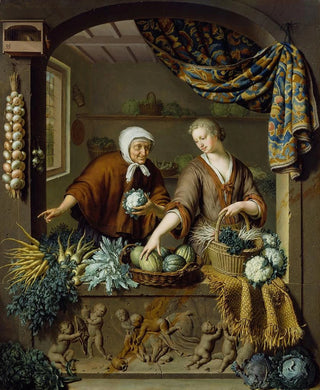Art print | The vegetable seller - Willem van Mieris


View from behind

Frame (optional)
In the vibrant world of 17th-century Dutch painting, "The Vegetable Seller" by Willem van Mieris stands out for its elegance and finesse. This artwork, imbued with realism and delicacy, immerses us in a market scene where the vibrant colors of fresh produce intertwine with the soft light filtering through the shadows. The artist, through this depiction, invites us to explore not only the beauty of vegetables but also the human interaction taking place in this everyday setting. The art print of this piece allows us to rediscover the magic of ordinary life, elevated by the gaze of a master.
Style and uniqueness of the work
Willem van Mieris's style is characterized by meticulous attention to detail and an exceptional mastery of light. In "The Vegetable Seller," every element is carefully rendered, from the textures of the vegetables to the expressions of the characters. The artist employs a palette of warm colors, creating an inviting atmosphere that feels almost tangible. The interplay of shadow and light reveals impressive depth, transforming a simple market scene into a rich and complex composition. This painting, while a faithful representation of daily life, also evokes a certain poetry, where the simplicity of objects becomes a source of wonder. van Mieris's ability to capture fleeting moments with such precision and sensitivity makes this work a must-see in the genre.
The artist and his influence
Willem van Mieris, born in Leiden in 1662, is often associated with the Dutch school of painting that flourished during the Golden Age. Son of the painter Frans van Mieris, he inherited a craftsmanship and artistic tradition from which he skillfully drew to develop his own style. Influenced by masters such as Jan Vermeer and Pieter de Hooch, van Mieris specialized in genre scenes, where he combined impeccable technique with narrative sensitivity. His work had a significant impact on his contemporaries and inspired many artists in their quest to depict daily life with such intensity. Through his approach, he contributed to elevating the genre of market scene paintings.

Matte finish

View from behind

Frame (optional)
In the vibrant world of 17th-century Dutch painting, "The Vegetable Seller" by Willem van Mieris stands out for its elegance and finesse. This artwork, imbued with realism and delicacy, immerses us in a market scene where the vibrant colors of fresh produce intertwine with the soft light filtering through the shadows. The artist, through this depiction, invites us to explore not only the beauty of vegetables but also the human interaction taking place in this everyday setting. The art print of this piece allows us to rediscover the magic of ordinary life, elevated by the gaze of a master.
Style and uniqueness of the work
Willem van Mieris's style is characterized by meticulous attention to detail and an exceptional mastery of light. In "The Vegetable Seller," every element is carefully rendered, from the textures of the vegetables to the expressions of the characters. The artist employs a palette of warm colors, creating an inviting atmosphere that feels almost tangible. The interplay of shadow and light reveals impressive depth, transforming a simple market scene into a rich and complex composition. This painting, while a faithful representation of daily life, also evokes a certain poetry, where the simplicity of objects becomes a source of wonder. van Mieris's ability to capture fleeting moments with such precision and sensitivity makes this work a must-see in the genre.
The artist and his influence
Willem van Mieris, born in Leiden in 1662, is often associated with the Dutch school of painting that flourished during the Golden Age. Son of the painter Frans van Mieris, he inherited a craftsmanship and artistic tradition from which he skillfully drew to develop his own style. Influenced by masters such as Jan Vermeer and Pieter de Hooch, van Mieris specialized in genre scenes, where he combined impeccable technique with narrative sensitivity. His work had a significant impact on his contemporaries and inspired many artists in their quest to depict daily life with such intensity. Through his approach, he contributed to elevating the genre of market scene paintings.






